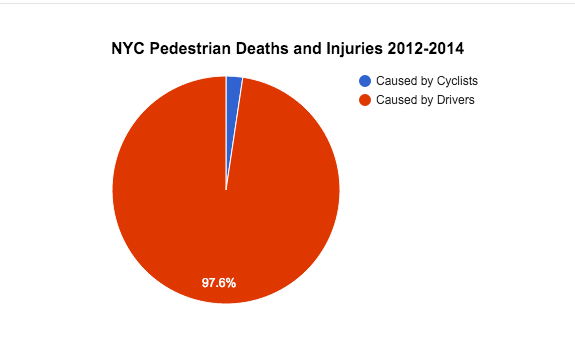On Wednesday, Manhattan Borough President Gale Brewer spoke in support of legislation that would create a "bicycle safety task force." The language of the bill, introduced by Council Member Rosie Mendez at Brewer's request, says the task force would make recommendations for improving bike infrastructure. But in testimony to the council transportation committee, Brewer suggested the panel would also provide a venue for people to gripe about cyclists.
“My office fields nearly daily complaints, many from seniors, who experience near misses with bikers, many of [whom] are breaking the law in some fashion,” Brewer said.
Earlier in the week Mendez staffer Matt Viggiano said basically the same thing to AMNY: "We have a lot of seniors who have called our office with complaints when cyclists don't follow the rules of the road, and present dangerous conditions for pedestrians."
There's no way to pinpoint the extent of the problem described by Brewer and Viggiano. The city does not track near-collisions between cyclists and pedestrians, just like it doesn't track near-collisions involving motorists or the actual incidence of traffic law-breaking. But for the past few years the city has collected data on reported collisions between people biking and walking. The numbers show that targeting bikes can't achieve major gains in pedestrian safety, because nearly all pedestrian injuries and deaths are caused by motorists.
DOT recently released 2014 figures on cyclist-pedestrian collisions [PDF] reported to NYPD. People on bikes struck and killed three NYC pedestrians last year, according to DOT, and injured 305 people walking. By comparison, motorists killed 134 pedestrians in 2014, and injured 10,981. So last year cyclists were accountable for just over 2 percent of pedestrian deaths, and less than 3 percent of injuries. And that year was an outlier for fatalities.
From 2000 through 2014, cyclists killed 11 people in NYC, while motorists killed 2,425 pedestrians, making cyclists accountable for .4 percent of deaths over 15 years.
The city didn't start releasing data on pedestrians injured by cyclists until 2011, and 2012 was the first data set to cover an entire year. Here's what we know from the three full years of data we have.
From 2012 through 2014, cyclists injured 865 people walking, and drivers injured 35,454. Over the three years for which data are available, cyclists were accountable for just over 2 percent of pedestrian injuries. Note that these comparisons don't account for the severity of injuries, which likely tends to be worse when people are struck by multi-ton motor vehicles than by someone on a bike.
We know that pedestrian safety and cyclist safety are fundamentally aligned. When DOT has redesigned streets with protected bike lanes, pedestrian injuries and deaths have dropped significantly. And when streets are designed for slower motor vehicle speeds, everyone is safer.
Inconsiderate and aggressive bike riding can be a problem, but it's not a significant threat to public safety. Creating a task force that would function as a venue to complain only about bicyclists will distract from the vastly more urgent task of preventing deaths and injuries caused by dangerous driving.






